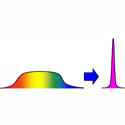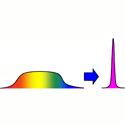Chirp and compress
The quantum mechanical entanglement of physically separated particles with linked properties is by now an experimentally established fact that has entered the realm of engineering applications in quantum metrology and cryptography. Among the most popular entangled states are entangled photon pairs, or biphotons.
Like all photons, biphotons are wave packets of energy. Compressing the envelope (or temporal width) of this wave packet, ideally to a single optical cycle, increases the power in the wave packet significantly and opens potential applications in nonlinear optical processes, nonclassical metrology, and large-bandwidth quantum information processing.
In 2007, Stephen Harris at Stanford University in the US proposed a method of generating single-cycle ultrashort biphotons. The process involves sending a pump laser beam through a nonlinear crystal that generates two lower energy entangled photons, whose frequencies are rapidly switched (chirped) in opposite directions.
But biphotons born with a chirp must be subsequently compressed to achieve the shortest possible temporal widths. In a paper in Physical Review Letters, Harris, with Steven Sensarn and Guang-Yu Yin, have now experimentally implemented a complete chirp-and-compress technique. They take advantage of the nonlocal nature of the entangled photons, directing one photon of the biphoton pair through a dispersive medium while inducing a time delay on the other. The dispersion experienced by one photon cancels out the dispersion of the second and the biphoton wave packet gets compressed.
While not obtaining a single-cycle biphoton, Sensarn et al. increase the compression and effective peak power of the biphoton by a factor of compared to the uncompressed, unchirped biphotons. – Manolis Antonoyiannakis
[1] S. E. Harris, Phys. Rev. Lett. 98, 063602 (2007).





